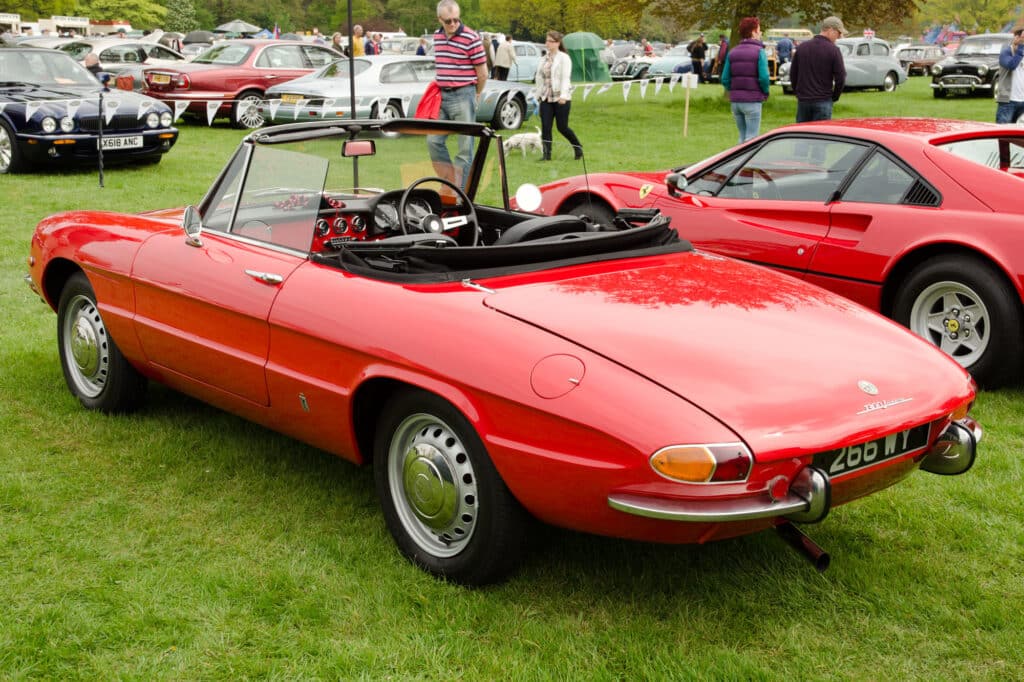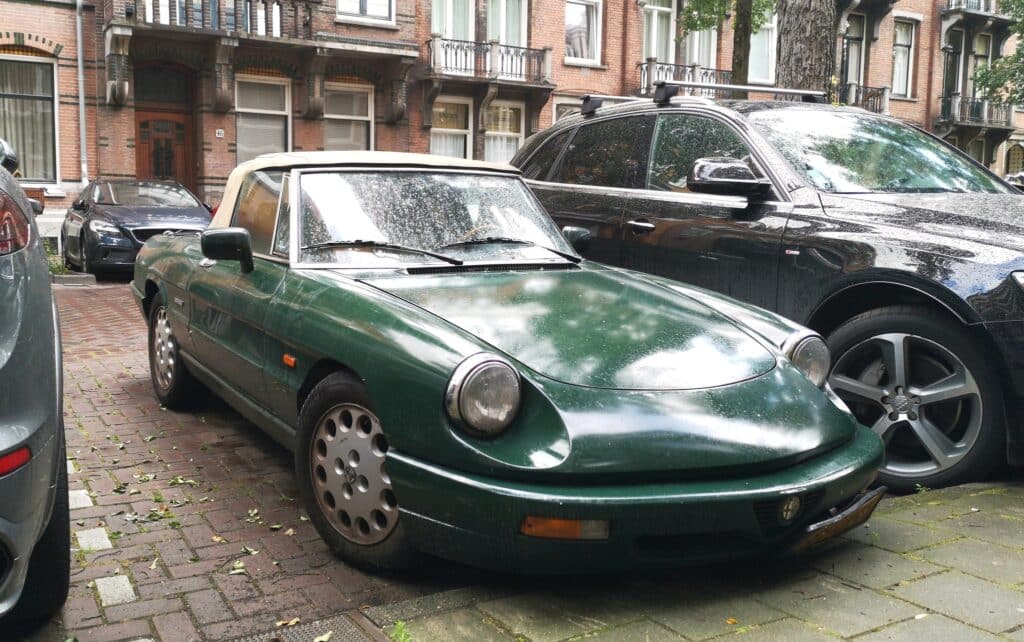Cars as we know them have been around for more than a century. During this time, a seemingly endless has been presented on the market, with different levels of success and impact. Many cars were mediocre, at best, while others were just boring or poorly designed and made. But every now and then, some car makers introduced a model that would wipe out the competition and stand out in the crowd. This could be a revolutionary technological innovation, such as fuel injection or anti-lock brakes. Or a whole new automotive concept, like when Renault came up with Espace, the first-ever minivan. But in some cases, making a car that looks stunning is enough. And that’s what Alfa Romeo did with their legendary roadster called Spider.
Alfa Romeo Spider – the background
Back in the 60s, a roadster was the most exciting car an average working-class Joe could buy. These agile two-seaters had several upsides that ultimately made them so desirable. Oddly, the performance of these cars, in terms of top speed and zero-to-sixty times, wasn’t so spectacular, but they had something else to offer. First of all, the roadster’s elegant body lines and the absence of a make it look stunning. Then, the mechanics are usually borrowed from more mundane, everyday models. This simplifies maintenance and lowers production costs, making these cars affordable. And most importantly, with their lightweight construction and sporty suspensions, most roadsters were thrilling on twisty roads.
The concept of a roadster was, in essence, invented and perfected by the British, who dominated this automotive segment. But obviously, other car makers would try to take a piece of that cake, with Alfa Romeo being one of them. At the time, this Italian manufacturer already had several roadsters in their portfolio. But successful as they may be, these cars were based on 4-door family cars, which had some limitations on their construction. So, to go head-to-head with the best, executives at Alfa Romeo decided to build a new model from the ground up. But given the importance of the project, this job wasn’t going to be done hastily and overnight. And to succeed, the new car would have to outgun its well-established British rivals. For this, Alfa had several aces up its sleeve. First, there are the engines, which revved fast and sounded fantastic while doing so. As such, they were ideal for blasting down the back roads. The rest of the mechanics weren’t bad either, as Alfa’s engineers already knew how to build a well-handling car. Predictably for an Italian car, its best part should be its looks. And this task was given to probably the most notable player in the game – Pininfarina.
The original Alfa Romeo Spider
After several years of extensive development, the all-new roadster was finally revealed at the 1966 Geneva Motor Show. And, in essence, Alfa Romeo got everything right with it. With its carbureted 4-cylinder engine, which just liked to be revved, and a snappy 5-speed transmission, the Spider was a fast car for its class. In addition, the handling through the bends was superb, thanks to a nicely-balanced suspension and excellent disc. But most importantly, besides being a thrill to drive, the Alfa Romeo Spider was also a pleasing sight. With sleek and elegant body panels, it was stunning from any angle. In simple words, this car, in which Pininfarina and his design team put a lot of effort, looked like it came from a gallery. And that was not the only art-related sensation, as that twin-cam engine sounded like it was crafted in an opera house. It had a magnificent exhaust note when pushed to the limit, which is what roadsters were all about.

To find a name that would catch the pure essence of this masterfully blended car, Alfa Romeo launched a public competition in which anybody could give their suggestion. And the winner would, apart from the sense of achievement, get that car as a prize. Eventually, the name Duetto, an Italian word for a duet, was chosen. Musical and clean, this was a perfect name for a car that represented driving pleasure in its purest form. Sadly, it was copyrighted, and Alfa named its freshly-designed roadster Spider, just like its previous similar cars. But ultimately, this was irrelevant because this roadster looked so good that it would get noticed no matter what it was called. And with excellent sales figures, that’s just what happened. Even the lack of reliability, which early Spiders suffered from, didn’t hurt its popularity. This was best portrayed in the Hollywood blockbuster the Graduate, which celebrated the car’s quirkiness in the scene where a faulty gauge causes Hoffman’s character to run out of fuel. But this, in the end, only glamorized the Spider and, more importantly, widened its appeal.
Following Alfa Romeo Spider Series
Having realized how well-received Spider was on the lucrative US market, Alfa Romeo decided to shift their focus to that side of the Atlantic. But this also meant the car had to be revised to meet the expectations of American buyers more closely. The resulting redesigned Series 2 Spider, introduced in 1970, featured many cosmetic and technical updates. Among them, the shape of the back end was the most notable. While the original Spider had a sleek, rounded trunk, the new car had a more boxy shape. This specific configuration, called Kamm tail or K-tail, offers several benefits, including better aerodynamics and increased luggage space. But despite the advantages, many viewed this as a design downfall over which Spider lost some of its appeals. Even more, some compromises had to be made over the years to meet strict US road regulations. For instance, chromed steel bumpers were replaced with unsightly black, rubbery ones. Or, to comply with requirements concerning headlights and their position, the car’s suspension was slightly raised. This created a noticeable gap under the wheel arches, a problem which was consequently solved by installing larger tires. But luckily for the famous Italian manufacturer, the redesigned car and all its future iterations remained liked by automotive enthusiasts.

Like with the design, changes were made to the mechanics to ensure they would be up to the task. More specifically, several engine displacements were available, with all cars sold in the US market having fuel injection, which made them more efficient and reliable. But when compared to engines with carburetors used in the previous cars, these were less responsive and had a less aggressive exhaust note. Still, none of this wasn’t something that would put off future buyers, and the sales continued to rise. Eventually, two further revisions were made, resulting in Series 3 and Series 4 cars. The last ever Alfa Romeo Spider left the assembly line in 1993, and it was replaced by a front-wheel-driven roadster that used the same name.
Buying an Alfa Romeo Spider Today
During its three-decade-long production run, approximately a quarter of a million of these agile and sleek sports cars were made. And those who haven’t fallen victim to the Italian car’s biggest enemy – corrosion – are still around. Unsurprisingly, Series 1 cars are the most desirable, which affects the asking prices. At this time, an original Alfa Romeo Spider costs between $30,000 and $140,000.

A brief summary of Alfa Romeo Spider
Alfa Romeo Spider is an Italian roadster made between 1966 and 1993, making it one of the longest-produced cars of its kind. During this time, the car was made in four distinctive series, numbered 1 to 4. While the Series 1 Spider looks significantly different from the later ones, they all share the same basic structure. This includes rev-happy 4-cylinder engines, snappy manual transmissions, and an agile suspension. Because it embodied everything a roadster should be, Alfa Romeo Spider was always favored by those who enjoy the thrill of driving. And it’s a beautiful car, which only adds to its appeal.





